Principles of Accounting, Financial Statements, and Ratios
VerifiedAdded on 2022/11/24
|28
|2478
|191
Homework Assignment
AI Summary
This accounting assignment solution delves into the fundamental principles of accounting, including conservatism, consistency, cost, economic entity, full disclosure, going concern, matching, materiality, monetary unit, reliability, revenue recognition, and time period principles. It identifies instances where these principles were not followed and suggests sustainable business practices. The solution includes a cash flow statement, a profit statement, and a statement of changes in equity for Balton Ltd. It also presents a financial position statement and a detailed ratio analysis (profitability, liquidity, and solvency) for Alpha Ltd., comparing performance over two years. Further, it provides journal entries, a trial balance, and adjusting entries to illustrate accounting procedures. The assignment covers key aspects of financial accounting, providing a comprehensive understanding of the subject.
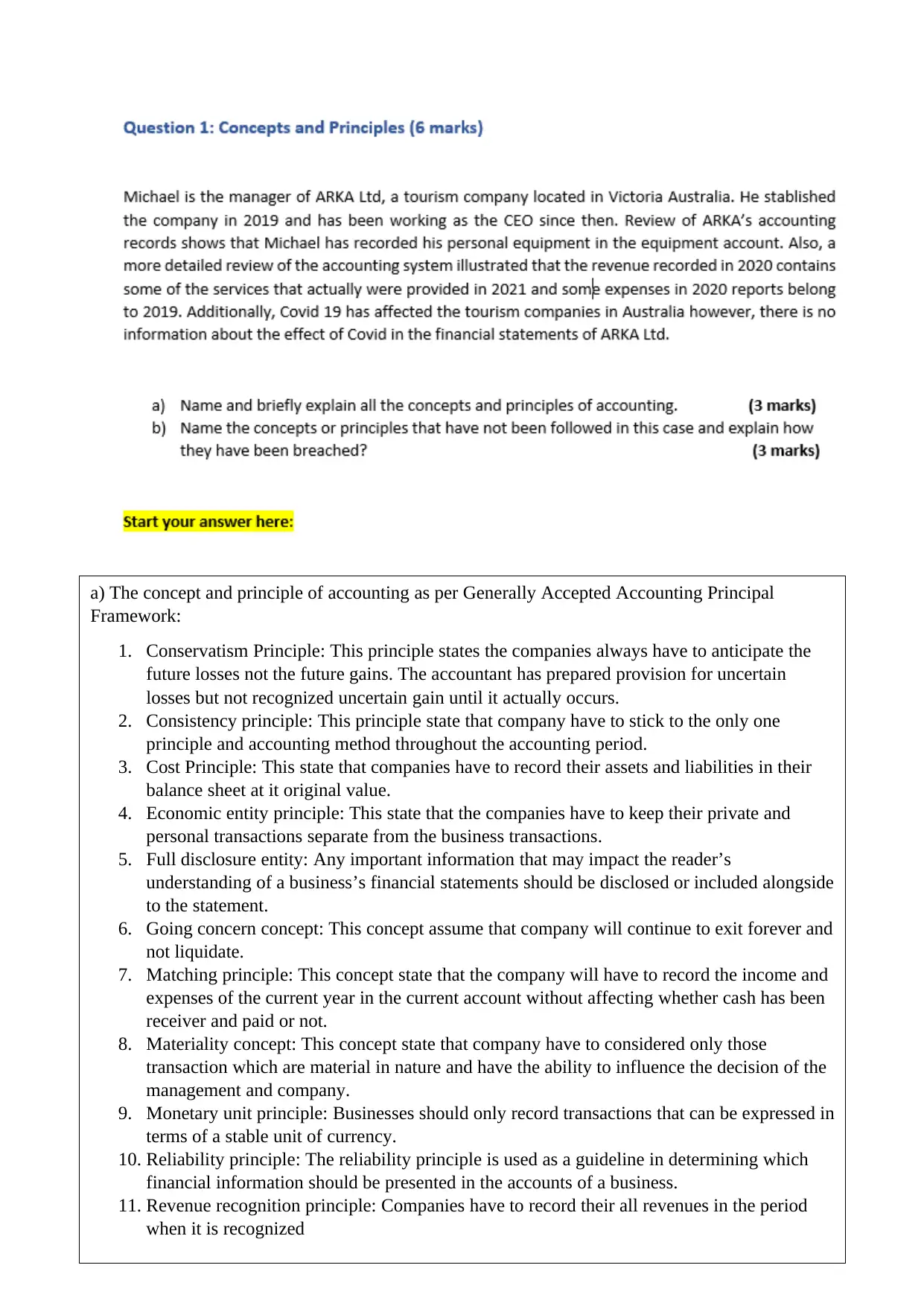
a) The concept and principle of accounting as per Generally Accepted Accounting Principal
Framework:
1. Conservatism Principle: This principle states the companies always have to anticipate the
future losses not the future gains. The accountant has prepared provision for uncertain
losses but not recognized uncertain gain until it actually occurs.
2. Consistency principle: This principle state that company have to stick to the only one
principle and accounting method throughout the accounting period.
3. Cost Principle: This state that companies have to record their assets and liabilities in their
balance sheet at it original value.
4. Economic entity principle: This state that the companies have to keep their private and
personal transactions separate from the business transactions.
5. Full disclosure entity: Any important information that may impact the reader’s
understanding of a business’s financial statements should be disclosed or included alongside
to the statement.
6. Going concern concept: This concept assume that company will continue to exit forever and
not liquidate.
7. Matching principle: This concept state that the company will have to record the income and
expenses of the current year in the current account without affecting whether cash has been
receiver and paid or not.
8. Materiality concept: This concept state that company have to considered only those
transaction which are material in nature and have the ability to influence the decision of the
management and company.
9. Monetary unit principle: Businesses should only record transactions that can be expressed in
terms of a stable unit of currency.
10. Reliability principle: The reliability principle is used as a guideline in determining which
financial information should be presented in the accounts of a business.
11. Revenue recognition principle: Companies have to record their all revenues in the period
when it is recognized
Framework:
1. Conservatism Principle: This principle states the companies always have to anticipate the
future losses not the future gains. The accountant has prepared provision for uncertain
losses but not recognized uncertain gain until it actually occurs.
2. Consistency principle: This principle state that company have to stick to the only one
principle and accounting method throughout the accounting period.
3. Cost Principle: This state that companies have to record their assets and liabilities in their
balance sheet at it original value.
4. Economic entity principle: This state that the companies have to keep their private and
personal transactions separate from the business transactions.
5. Full disclosure entity: Any important information that may impact the reader’s
understanding of a business’s financial statements should be disclosed or included alongside
to the statement.
6. Going concern concept: This concept assume that company will continue to exit forever and
not liquidate.
7. Matching principle: This concept state that the company will have to record the income and
expenses of the current year in the current account without affecting whether cash has been
receiver and paid or not.
8. Materiality concept: This concept state that company have to considered only those
transaction which are material in nature and have the ability to influence the decision of the
management and company.
9. Monetary unit principle: Businesses should only record transactions that can be expressed in
terms of a stable unit of currency.
10. Reliability principle: The reliability principle is used as a guideline in determining which
financial information should be presented in the accounts of a business.
11. Revenue recognition principle: Companies have to record their all revenues in the period
when it is recognized
Paraphrase This Document
Need a fresh take? Get an instant paraphrase of this document with our AI Paraphraser
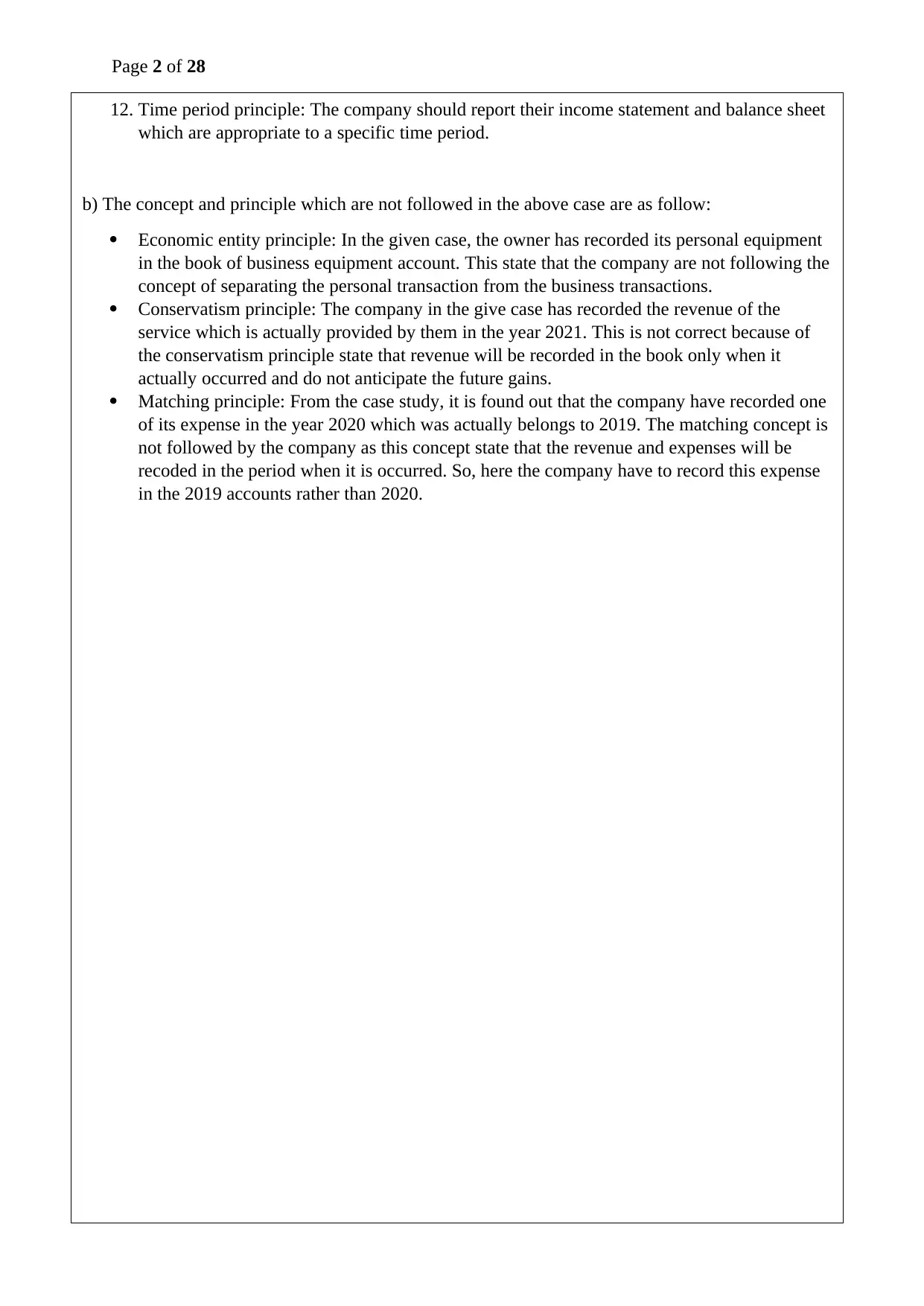
Page 2 of 28
12. Time period principle: The company should report their income statement and balance sheet
which are appropriate to a specific time period.
b) The concept and principle which are not followed in the above case are as follow:
Economic entity principle: In the given case, the owner has recorded its personal equipment
in the book of business equipment account. This state that the company are not following the
concept of separating the personal transaction from the business transactions.
Conservatism principle: The company in the give case has recorded the revenue of the
service which is actually provided by them in the year 2021. This is not correct because of
the conservatism principle state that revenue will be recorded in the book only when it
actually occurred and do not anticipate the future gains.
Matching principle: From the case study, it is found out that the company have recorded one
of its expense in the year 2020 which was actually belongs to 2019. The matching concept is
not followed by the company as this concept state that the revenue and expenses will be
recoded in the period when it is occurred. So, here the company have to record this expense
in the 2019 accounts rather than 2020.
12. Time period principle: The company should report their income statement and balance sheet
which are appropriate to a specific time period.
b) The concept and principle which are not followed in the above case are as follow:
Economic entity principle: In the given case, the owner has recorded its personal equipment
in the book of business equipment account. This state that the company are not following the
concept of separating the personal transaction from the business transactions.
Conservatism principle: The company in the give case has recorded the revenue of the
service which is actually provided by them in the year 2021. This is not correct because of
the conservatism principle state that revenue will be recorded in the book only when it
actually occurred and do not anticipate the future gains.
Matching principle: From the case study, it is found out that the company have recorded one
of its expense in the year 2020 which was actually belongs to 2019. The matching concept is
not followed by the company as this concept state that the revenue and expenses will be
recoded in the period when it is occurred. So, here the company have to record this expense
in the 2019 accounts rather than 2020.
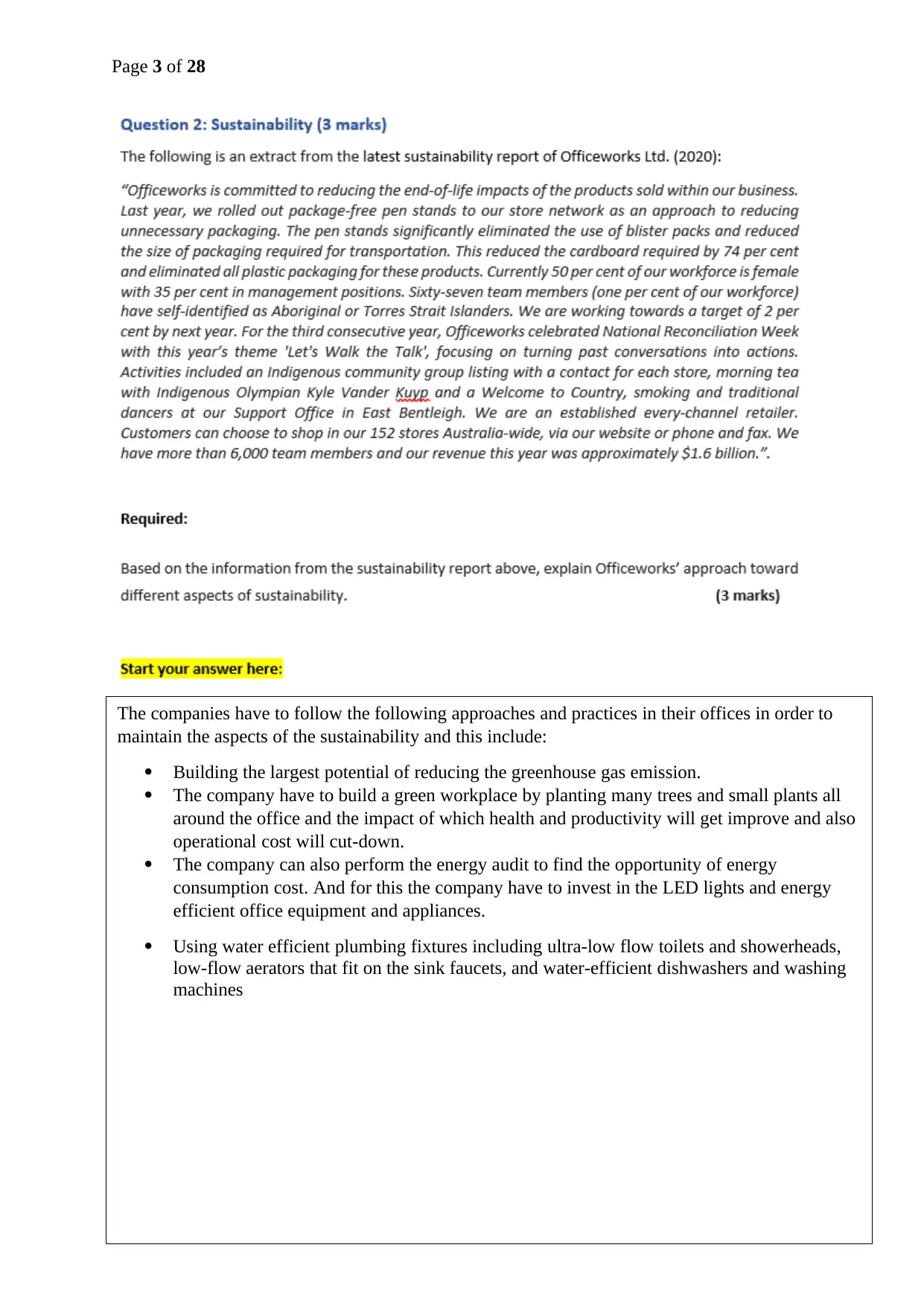
Page 3 of 28
The companies have to follow the following approaches and practices in their offices in order to
maintain the aspects of the sustainability and this include:
Building the largest potential of reducing the greenhouse gas emission.
The company have to build a green workplace by planting many trees and small plants all
around the office and the impact of which health and productivity will get improve and also
operational cost will cut-down.
The company can also perform the energy audit to find the opportunity of energy
consumption cost. And for this the company have to invest in the LED lights and energy
efficient office equipment and appliances.
Using water efficient plumbing fixtures including ultra-low flow toilets and showerheads,
low-flow aerators that fit on the sink faucets, and water-efficient dishwashers and washing
machines
The companies have to follow the following approaches and practices in their offices in order to
maintain the aspects of the sustainability and this include:
Building the largest potential of reducing the greenhouse gas emission.
The company have to build a green workplace by planting many trees and small plants all
around the office and the impact of which health and productivity will get improve and also
operational cost will cut-down.
The company can also perform the energy audit to find the opportunity of energy
consumption cost. And for this the company have to invest in the LED lights and energy
efficient office equipment and appliances.
Using water efficient plumbing fixtures including ultra-low flow toilets and showerheads,
low-flow aerators that fit on the sink faucets, and water-efficient dishwashers and washing
machines
⊘ This is a preview!⊘
Do you want full access?
Subscribe today to unlock all pages.

Trusted by 1+ million students worldwide
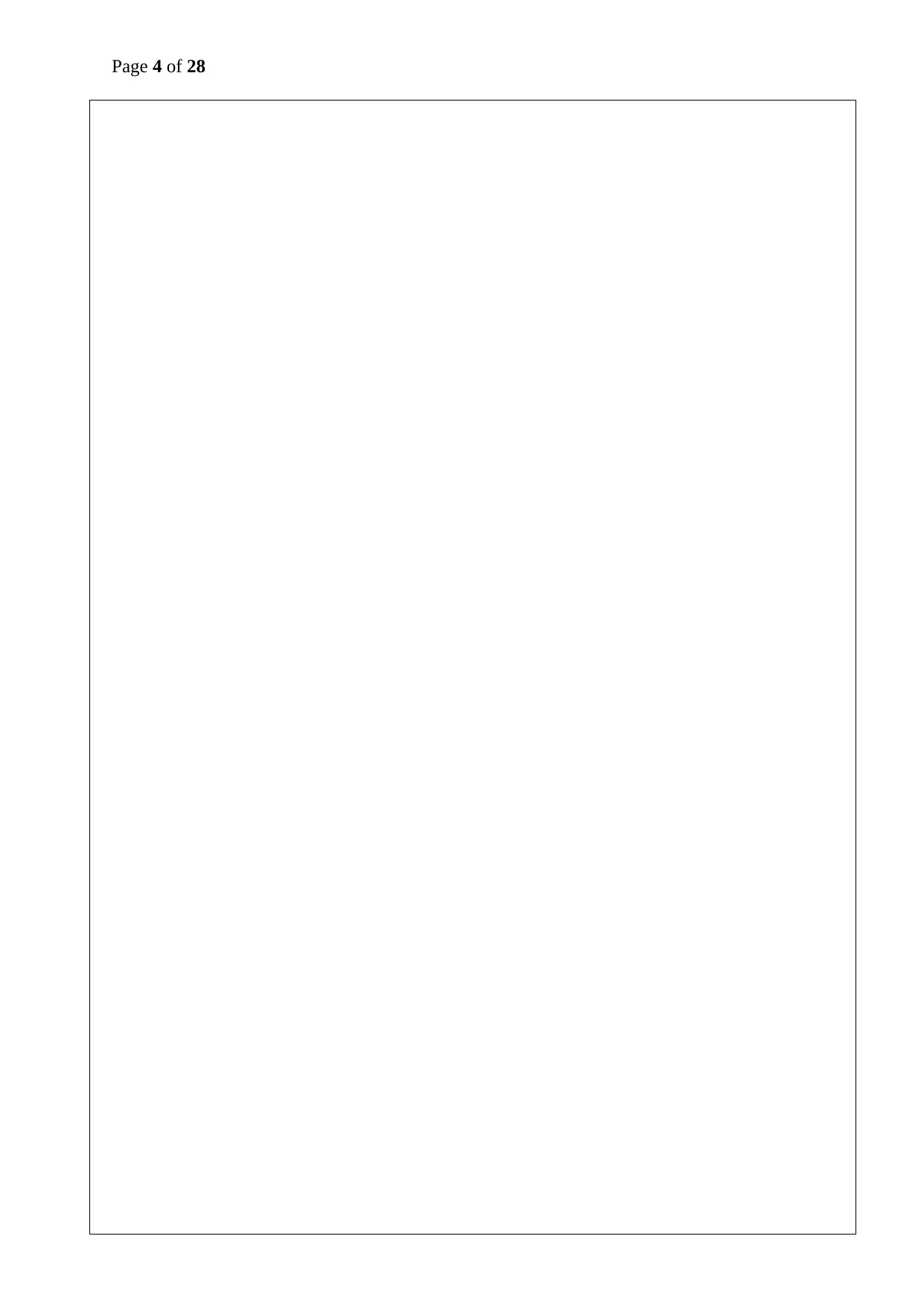
Page 4 of 28
Paraphrase This Document
Need a fresh take? Get an instant paraphrase of this document with our AI Paraphraser
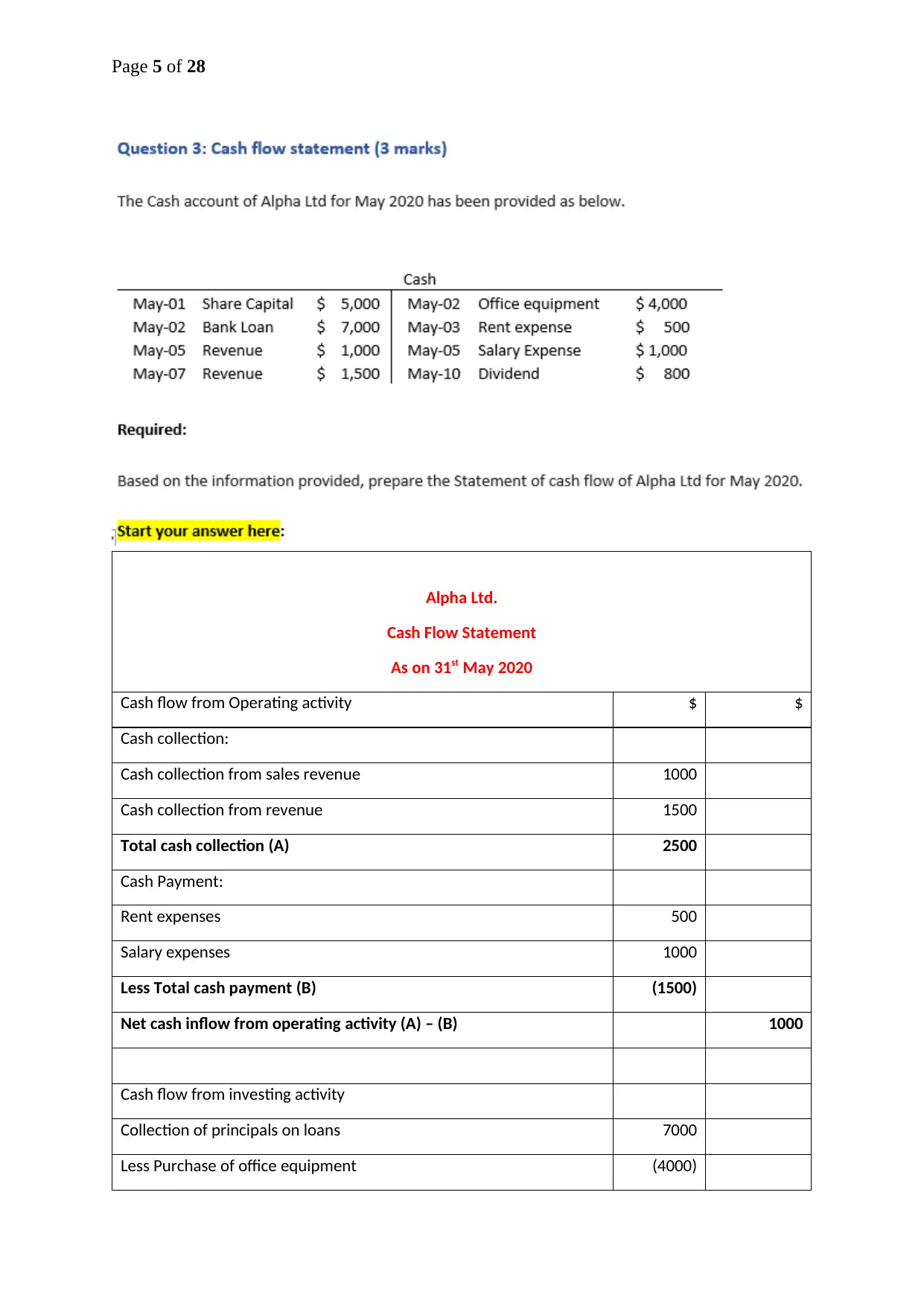
Page 5 of 28
Alpha Ltd.
Cash Flow Statement
As on 31st May 2020
Cash flow from Operating activity $ $
Cash collection:
Cash collection from sales revenue 1000
Cash collection from revenue 1500
Total cash collection (A) 2500
Cash Payment:
Rent expenses 500
Salary expenses 1000
Less Total cash payment (B) (1500)
Net cash inflow from operating activity (A) – (B) 1000
Cash flow from investing activity
Collection of principals on loans 7000
Less Purchase of office equipment (4000)
Alpha Ltd.
Cash Flow Statement
As on 31st May 2020
Cash flow from Operating activity $ $
Cash collection:
Cash collection from sales revenue 1000
Cash collection from revenue 1500
Total cash collection (A) 2500
Cash Payment:
Rent expenses 500
Salary expenses 1000
Less Total cash payment (B) (1500)
Net cash inflow from operating activity (A) – (B) 1000
Cash flow from investing activity
Collection of principals on loans 7000
Less Purchase of office equipment (4000)
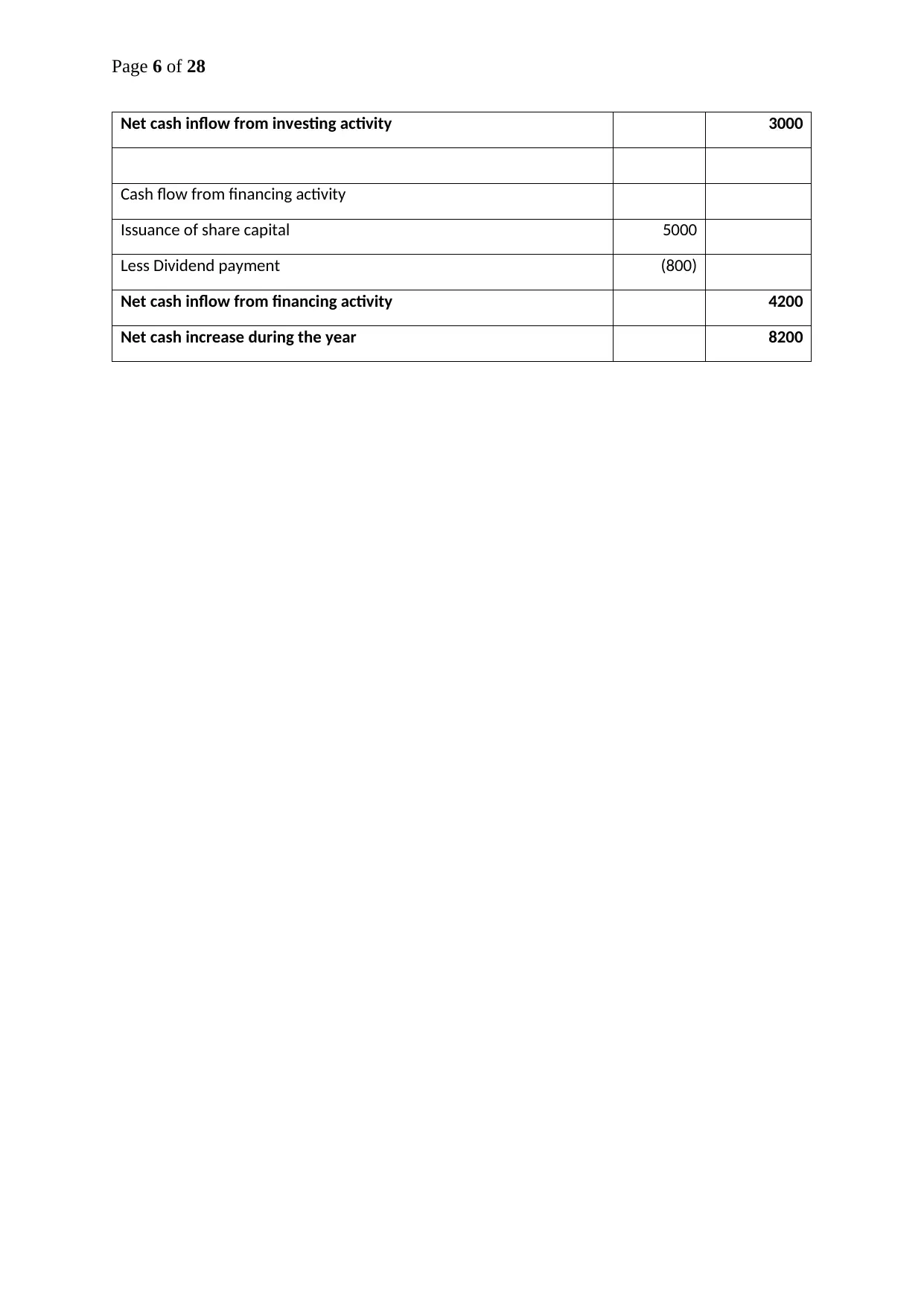
Page 6 of 28
Net cash inflow from investing activity 3000
Cash flow from financing activity
Issuance of share capital 5000
Less Dividend payment (800)
Net cash inflow from financing activity 4200
Net cash increase during the year 8200
Net cash inflow from investing activity 3000
Cash flow from financing activity
Issuance of share capital 5000
Less Dividend payment (800)
Net cash inflow from financing activity 4200
Net cash increase during the year 8200
⊘ This is a preview!⊘
Do you want full access?
Subscribe today to unlock all pages.

Trusted by 1+ million students worldwide
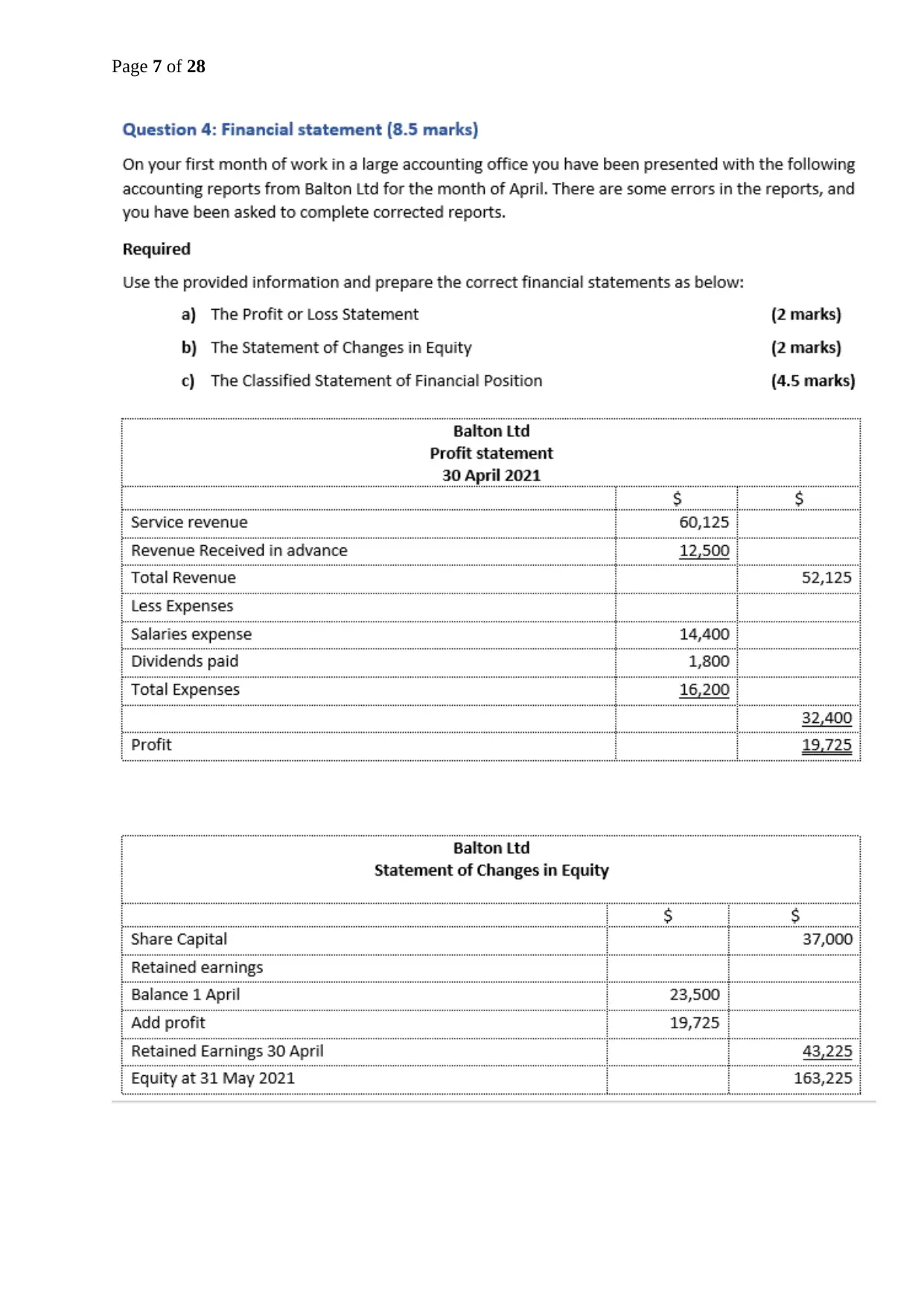
Page 7 of 28
Paraphrase This Document
Need a fresh take? Get an instant paraphrase of this document with our AI Paraphraser
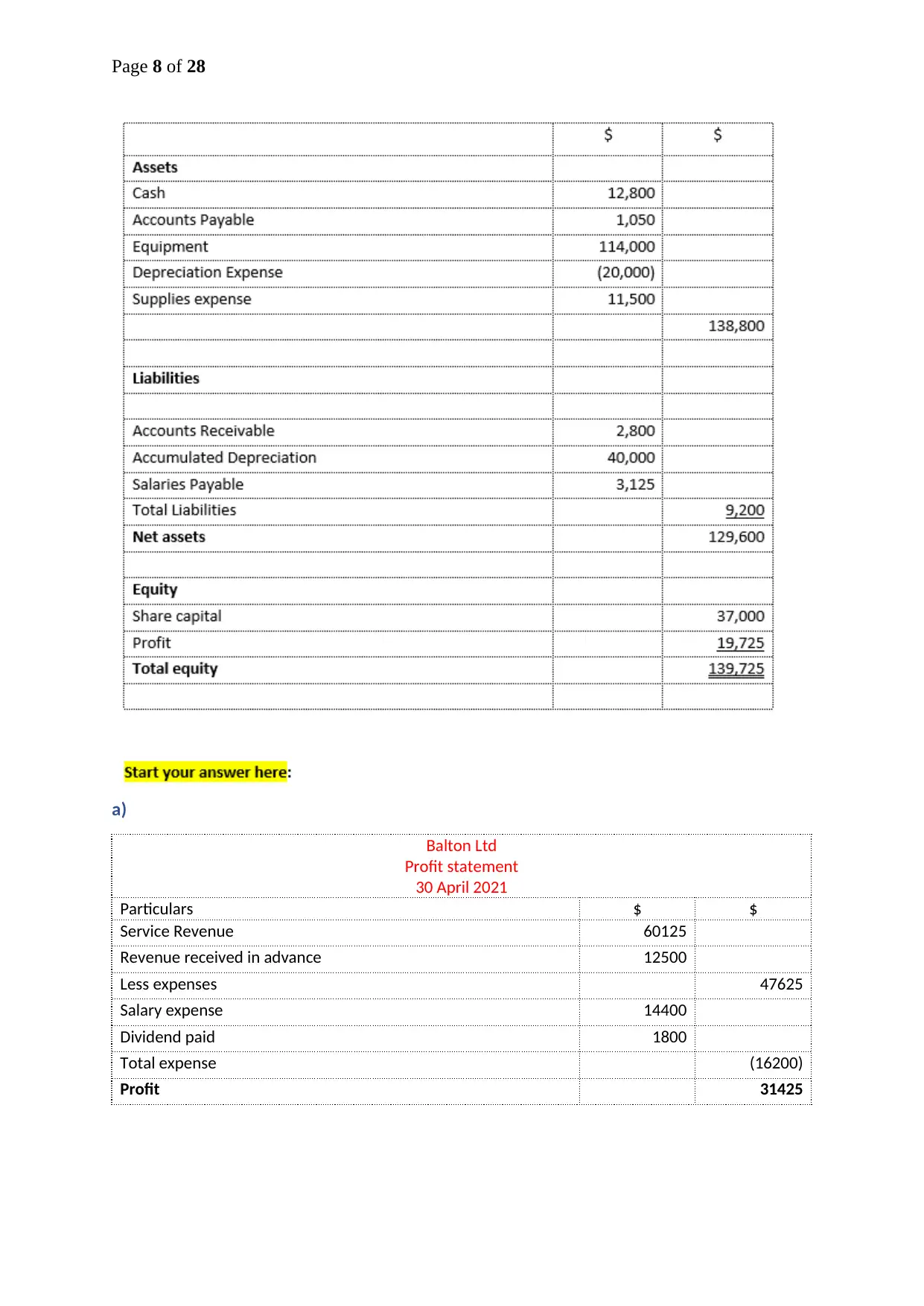
Page 8 of 28
a)
Balton Ltd
Profit statement
30 April 2021
Particulars $ $
Service Revenue 60125
Revenue received in advance 12500
Less expenses 47625
Salary expense 14400
Dividend paid 1800
Total expense (16200)
Profit 31425
a)
Balton Ltd
Profit statement
30 April 2021
Particulars $ $
Service Revenue 60125
Revenue received in advance 12500
Less expenses 47625
Salary expense 14400
Dividend paid 1800
Total expense (16200)
Profit 31425
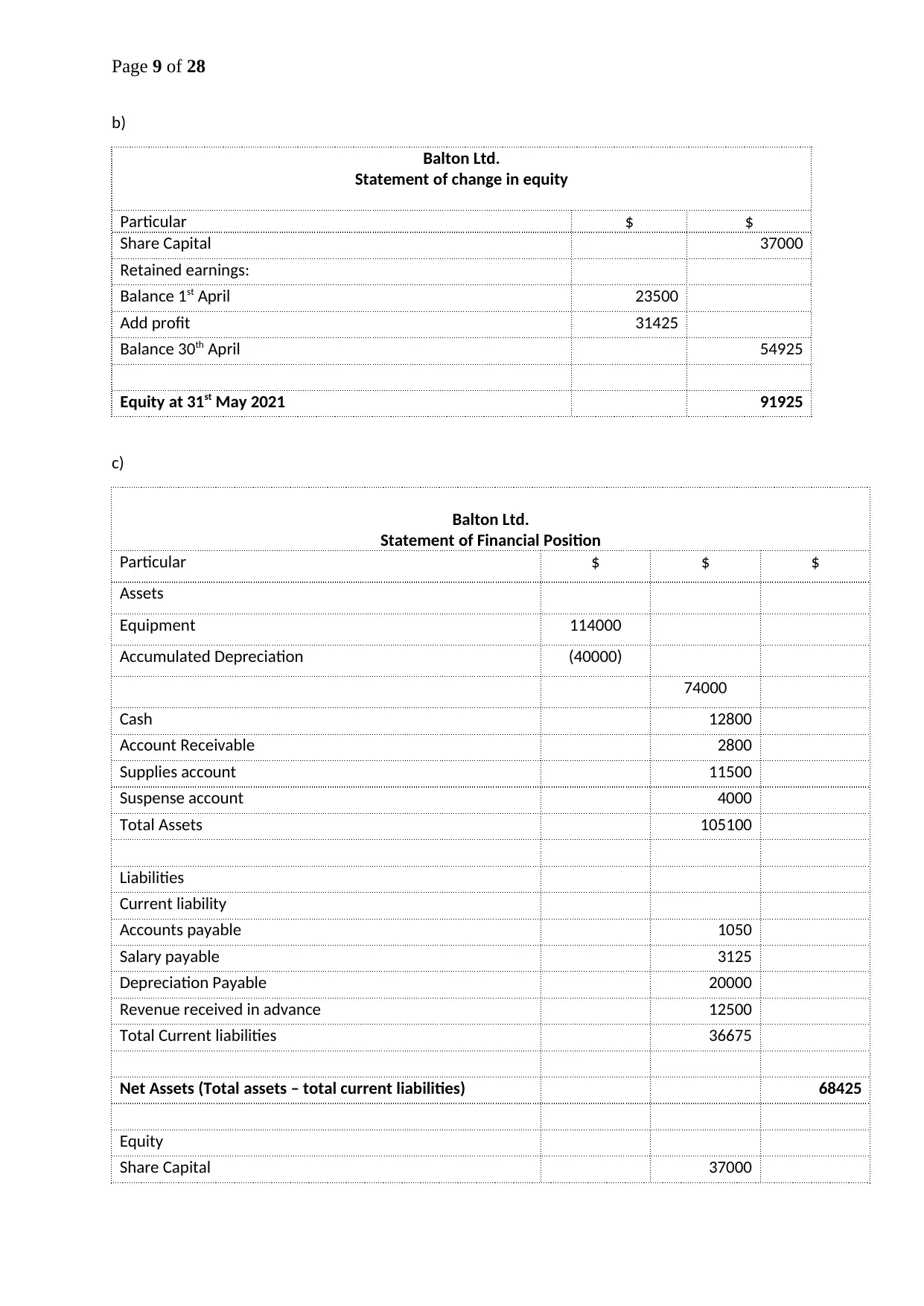
Page 9 of 28
b)
Balton Ltd.
Statement of change in equity
Particular $ $
Share Capital 37000
Retained earnings:
Balance 1st April 23500
Add profit 31425
Balance 30th April 54925
Equity at 31st May 2021 91925
c)
Balton Ltd.
Statement of Financial Position
Particular $ $ $
Assets
Equipment 114000
Accumulated Depreciation (40000)
74000
Cash 12800
Account Receivable 2800
Supplies account 11500
Suspense account 4000
Total Assets 105100
Liabilities
Current liability
Accounts payable 1050
Salary payable 3125
Depreciation Payable 20000
Revenue received in advance 12500
Total Current liabilities 36675
Net Assets (Total assets – total current liabilities) 68425
Equity
Share Capital 37000
b)
Balton Ltd.
Statement of change in equity
Particular $ $
Share Capital 37000
Retained earnings:
Balance 1st April 23500
Add profit 31425
Balance 30th April 54925
Equity at 31st May 2021 91925
c)
Balton Ltd.
Statement of Financial Position
Particular $ $ $
Assets
Equipment 114000
Accumulated Depreciation (40000)
74000
Cash 12800
Account Receivable 2800
Supplies account 11500
Suspense account 4000
Total Assets 105100
Liabilities
Current liability
Accounts payable 1050
Salary payable 3125
Depreciation Payable 20000
Revenue received in advance 12500
Total Current liabilities 36675
Net Assets (Total assets – total current liabilities) 68425
Equity
Share Capital 37000
⊘ This is a preview!⊘
Do you want full access?
Subscribe today to unlock all pages.

Trusted by 1+ million students worldwide
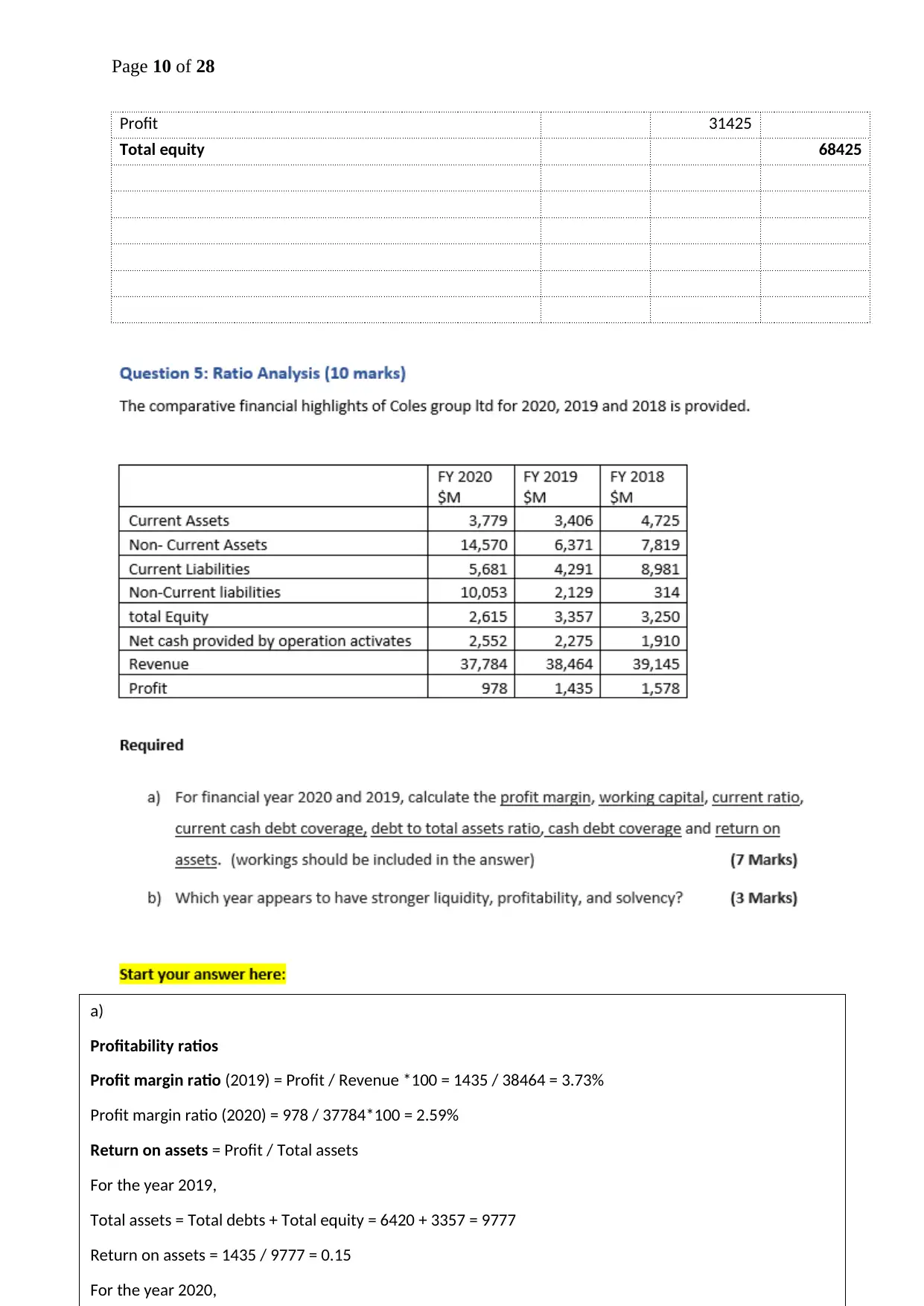
Page 10 of 28
Profit 31425
Total equity 68425
a)
Profitability ratios
Profit margin ratio (2019) = Profit / Revenue *100 = 1435 / 38464 = 3.73%
Profit margin ratio (2020) = 978 / 37784*100 = 2.59%
Return on assets = Profit / Total assets
For the year 2019,
Total assets = Total debts + Total equity = 6420 + 3357 = 9777
Return on assets = 1435 / 9777 = 0.15
For the year 2020,
Profit 31425
Total equity 68425
a)
Profitability ratios
Profit margin ratio (2019) = Profit / Revenue *100 = 1435 / 38464 = 3.73%
Profit margin ratio (2020) = 978 / 37784*100 = 2.59%
Return on assets = Profit / Total assets
For the year 2019,
Total assets = Total debts + Total equity = 6420 + 3357 = 9777
Return on assets = 1435 / 9777 = 0.15
For the year 2020,
Paraphrase This Document
Need a fresh take? Get an instant paraphrase of this document with our AI Paraphraser
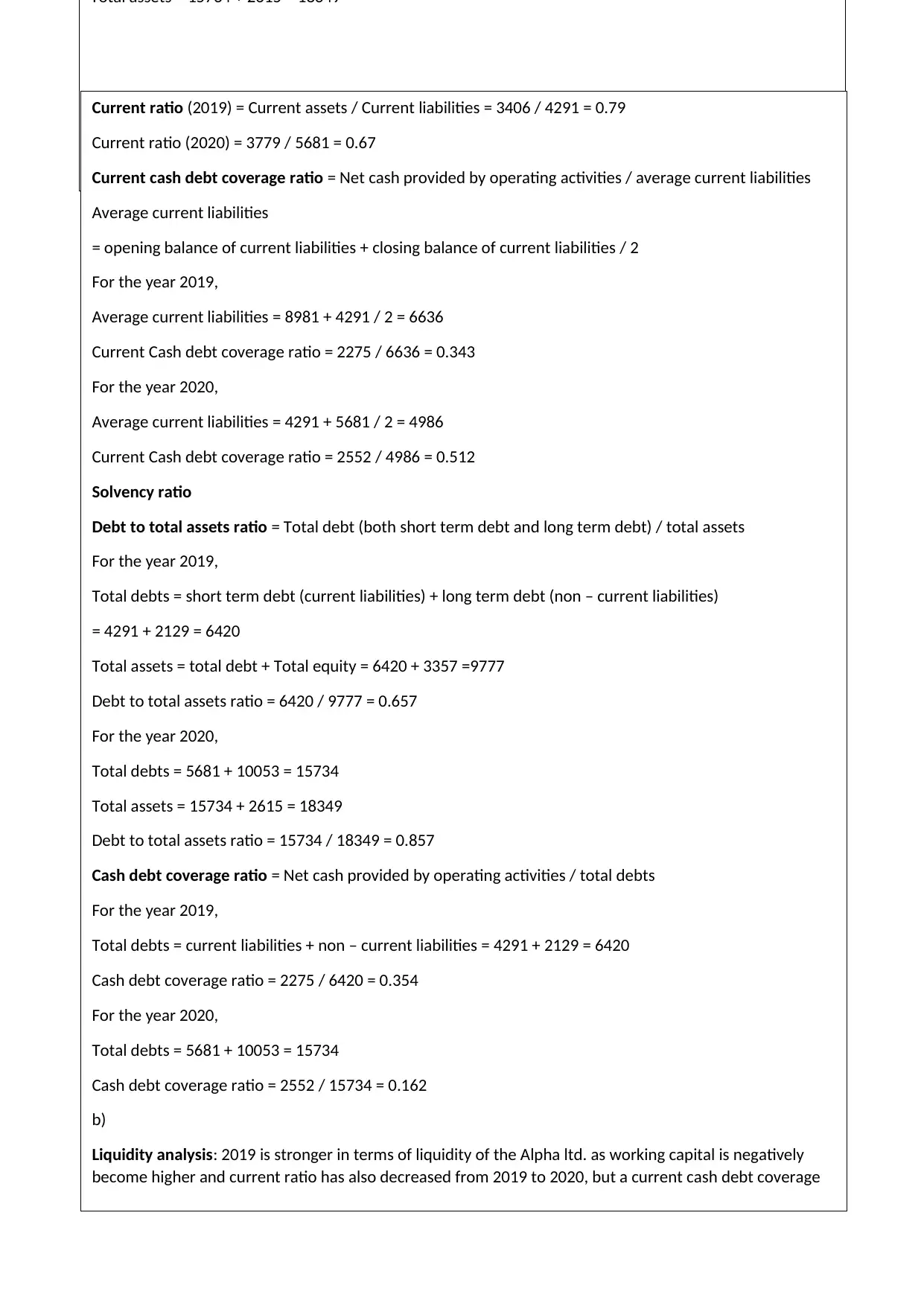
Page 11 of 28
Total assets = 15734 + 2615 = 18349
Current ratio (2019) = Current assets / Current liabilities = 3406 / 4291 = 0.79
Current ratio (2020) = 3779 / 5681 = 0.67
Current cash debt coverage ratio = Net cash provided by operating activities / average current liabilities
Average current liabilities
= opening balance of current liabilities + closing balance of current liabilities / 2
For the year 2019,
Average current liabilities = 8981 + 4291 / 2 = 6636
Current Cash debt coverage ratio = 2275 / 6636 = 0.343
For the year 2020,
Average current liabilities = 4291 + 5681 / 2 = 4986
Current Cash debt coverage ratio = 2552 / 4986 = 0.512
Solvency ratio
Debt to total assets ratio = Total debt (both short term debt and long term debt) / total assets
For the year 2019,
Total debts = short term debt (current liabilities) + long term debt (non – current liabilities)
= 4291 + 2129 = 6420
Total assets = total debt + Total equity = 6420 + 3357 =9777
Debt to total assets ratio = 6420 / 9777 = 0.657
For the year 2020,
Total debts = 5681 + 10053 = 15734
Total assets = 15734 + 2615 = 18349
Debt to total assets ratio = 15734 / 18349 = 0.857
Cash debt coverage ratio = Net cash provided by operating activities / total debts
For the year 2019,
Total debts = current liabilities + non – current liabilities = 4291 + 2129 = 6420
Cash debt coverage ratio = 2275 / 6420 = 0.354
For the year 2020,
Total debts = 5681 + 10053 = 15734
Cash debt coverage ratio = 2552 / 15734 = 0.162
b)
Liquidity analysis: 2019 is stronger in terms of liquidity of the Alpha ltd. as working capital is negatively
become higher and current ratio has also decreased from 2019 to 2020, but a current cash debt coverage
Total assets = 15734 + 2615 = 18349
Current ratio (2019) = Current assets / Current liabilities = 3406 / 4291 = 0.79
Current ratio (2020) = 3779 / 5681 = 0.67
Current cash debt coverage ratio = Net cash provided by operating activities / average current liabilities
Average current liabilities
= opening balance of current liabilities + closing balance of current liabilities / 2
For the year 2019,
Average current liabilities = 8981 + 4291 / 2 = 6636
Current Cash debt coverage ratio = 2275 / 6636 = 0.343
For the year 2020,
Average current liabilities = 4291 + 5681 / 2 = 4986
Current Cash debt coverage ratio = 2552 / 4986 = 0.512
Solvency ratio
Debt to total assets ratio = Total debt (both short term debt and long term debt) / total assets
For the year 2019,
Total debts = short term debt (current liabilities) + long term debt (non – current liabilities)
= 4291 + 2129 = 6420
Total assets = total debt + Total equity = 6420 + 3357 =9777
Debt to total assets ratio = 6420 / 9777 = 0.657
For the year 2020,
Total debts = 5681 + 10053 = 15734
Total assets = 15734 + 2615 = 18349
Debt to total assets ratio = 15734 / 18349 = 0.857
Cash debt coverage ratio = Net cash provided by operating activities / total debts
For the year 2019,
Total debts = current liabilities + non – current liabilities = 4291 + 2129 = 6420
Cash debt coverage ratio = 2275 / 6420 = 0.354
For the year 2020,
Total debts = 5681 + 10053 = 15734
Cash debt coverage ratio = 2552 / 15734 = 0.162
b)
Liquidity analysis: 2019 is stronger in terms of liquidity of the Alpha ltd. as working capital is negatively
become higher and current ratio has also decreased from 2019 to 2020, but a current cash debt coverage
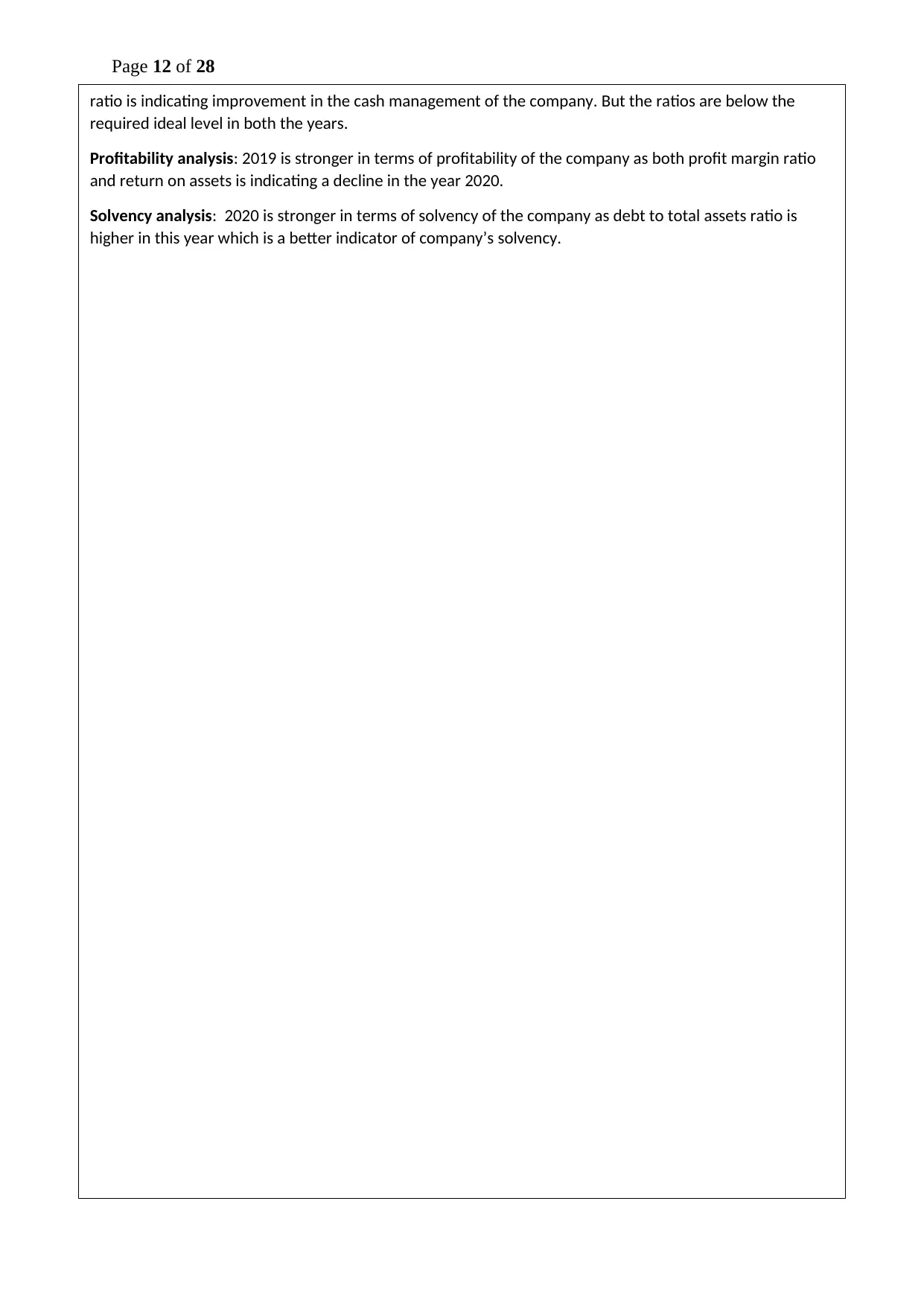
Page 12 of 28
ratio is indicating improvement in the cash management of the company. But the ratios are below the
required ideal level in both the years.
Profitability analysis: 2019 is stronger in terms of profitability of the company as both profit margin ratio
and return on assets is indicating a decline in the year 2020.
Solvency analysis: 2020 is stronger in terms of solvency of the company as debt to total assets ratio is
higher in this year which is a better indicator of company’s solvency.
ratio is indicating improvement in the cash management of the company. But the ratios are below the
required ideal level in both the years.
Profitability analysis: 2019 is stronger in terms of profitability of the company as both profit margin ratio
and return on assets is indicating a decline in the year 2020.
Solvency analysis: 2020 is stronger in terms of solvency of the company as debt to total assets ratio is
higher in this year which is a better indicator of company’s solvency.
⊘ This is a preview!⊘
Do you want full access?
Subscribe today to unlock all pages.

Trusted by 1+ million students worldwide
1 out of 28
Related Documents
Your All-in-One AI-Powered Toolkit for Academic Success.
+13062052269
info@desklib.com
Available 24*7 on WhatsApp / Email
![[object Object]](/_next/static/media/star-bottom.7253800d.svg)
Unlock your academic potential
Copyright © 2020–2025 A2Z Services. All Rights Reserved. Developed and managed by ZUCOL.





